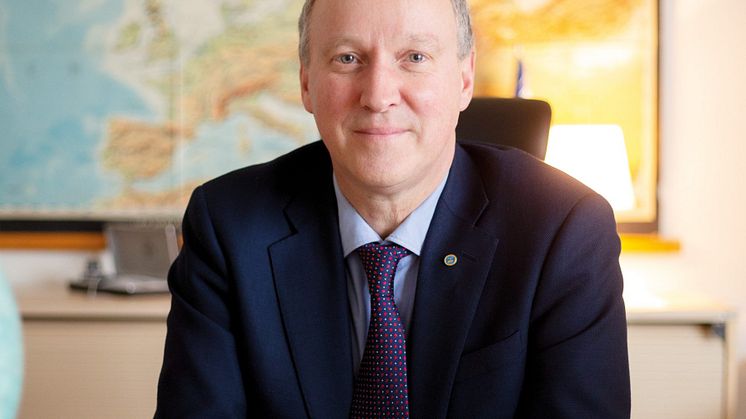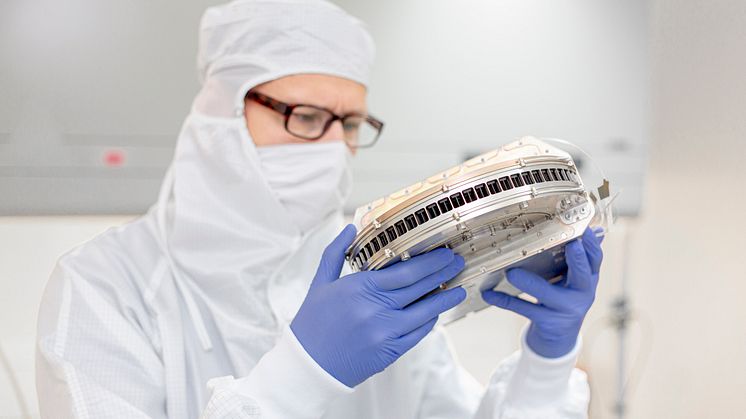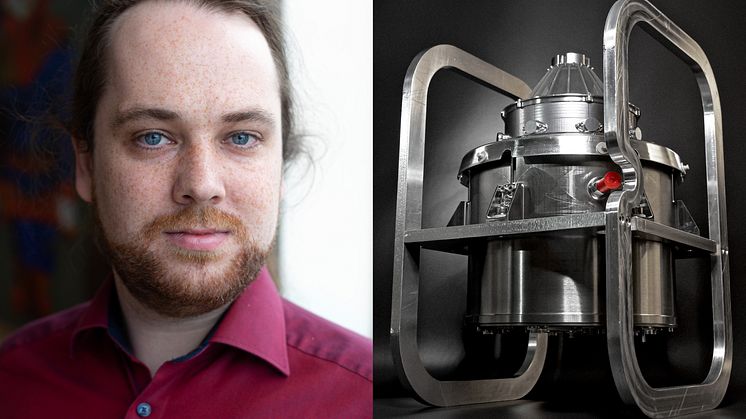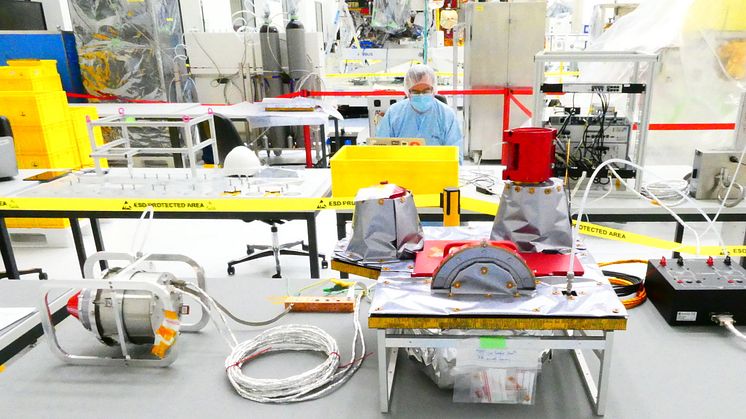
Pressmeddelande -
Svenska rymdinstrument på väg för att studera Jupiters isiga månar - lyckad uppsändning av rymdsonden Juice / Swedish space instruments on their way to study Jupiter's icy moons - successful launch of the Juice spacecraft
Kl. 14.14, svensk tid, den 14 april sändes den europeiska rymdsonden Juice upp från Franska Guyana med destination Jupiter och dess isiga månar Europa, Callisto och Ganymedes. Institutet för rymdfysik (IRF) ansvarar för två av de tio vetenskapliga rymdinstrumenten ombord på Europas största vetenskapliga rymdexpedition någonsin. Huvudmålet är att ta reda på om det finns förutsättningar för liv på Jupiters månar.
Efter decennier med förberedelser har nu den åtta år långa resan påbörjats för den europeiska rymdorganisationen ESA:s rymdsond JUpiter ICy moons Explorer (Juice). I juli 2031 kommer Juice fram till Jupiter och månarna som består av hav under lager av is.
Rymdinstrumenten som forskare vid IRF i Kiruna och Uppsala ansvarar för deltar inte bara i sökandet efter förutsättningarna till liv utan de kommer även undersöka det komplexa samspelet mellan Jupiter, dess isiga månar och rymdmiljön.
Stas Barabash är professor vid IRF i Kiruna och huvudansvarig för instrumentet Particle Environment Package, PEP, som består av sex olika sensorer som mäter de olika typer av neutrala och laddade partiklar som finns i Jupitersystemet.
Instrumentet kommer att utforska månarnas tunna atmosfärer, Ganymedes magnetosfär, söka efter signaturer av liv i gejsrar som sprutar ur från Europa samt undersöka Callisto. Genom att befinna sig i Jupiters magnetosfär kan PEP studera hur den fungerar och påverkar hela Jupitersystemet.
”Jupiter och dess system av månar är så komplexa och individuella så att studera dem är som att flyga igenom ett helt nytt solsystem, som kanske till och med kan hysa liv! Efter den lyckade uppsändningen så är nästa milstolpe att slå på PEP för första gången för att kontrollera att allt fungerar. Om allt går bra är det sedan dags att ha tålamod under åtta år och jag ser verkligen fram emot fantastiska upptäckter”, säger Stas Barabash.
Jan-Erik Wahlund är docent vid IRF i Uppsala och huvudansvarig för instrumentet Radio and Plasma Wave Investigation, RPWI, som består av tio olika sensorer som mäter elektriska och magnetiska fält samt kalljoniserad gas.
Instrumentet kommer att undersöka de isiga månarnas atmosfärer, strukturen hos de underjordiska oceanerna under Europas, Ganymedes och eventuellt Callistos isiga ytor. RPWI kommer också att undersöka bland annat de isiga månarnas inre miljöer samt kartlägga elektriska strömmar.
”Vi forskare vill flyga till Jupiter och dess isiga månar eftersom vi vill veta hur detta ”solsystem” i miniatyr fungerar. Finns det förutsättningar för liv? Hur skapades det och hur kommer det att utvecklas? Samtidigt är detta en första utforskning som kommer att hjälpa de som tar vid efter oss. Forskarna är de första på plats i nya världar och Juice är just en sådan mission som bryter helt ny mark”, säger Jan-Erik Wahlund.
Juice är inte bara Europas största vetenskapliga rymdexpedition någonsin, det är dessutom det största och mest komplexa rymdprojektet i IRF:s historia. IRF valdes ut av ESA 2013 att bidra med instrumenten PEP och RPWI, som delfinansierats av Rymdstyrelsen.
Olle Norberg är generaldirektör vid IRF och har tillsammans med Stas Barabash och Jan-Erik Wahlund följt uppsändningen på plats i Franska Guyana.
”Valet av IRF som ansvarig för två av tio instrument ombord på den prestigefyllda rymdsonden Juice är ett tydligt erkännande av IRF som ett ledande rymdforskningsinstitut i Europa. IRF kommer nu att samarbeta med forskare från hela världen för att studera Jupiters isiga månar”, säger Olle Norberg.
PRESSBILDER – IRF: https://cloud.irf.se/s/qkySDWAjB97QfD7
Kontakt:
Professor Stas Barabash, Institutet för rymdfysik, huvudansvarig för mätinstrumentet Particle Environment Package, PEP.
+46 980 791 22
stas.barabash@irf.se
Docent Jan-Erik Wahlund, Institutet för rymdfysik, huvudansvarig för mätinstrumentet Radio and Plasma Wave Investigation, RPWI.
+46 767 697 877
jan-erik.wahlund@irfu.se
Olle Norberg, generaldirektör, Institutet för rymdfysik
+46 980 790 78
olle.norberg@irf.se
Presskontakt:
Martin Eriksson, Informatör, Institutet för rymdfysik.
072- 581 33 33
martin.eriksson@irf.se
Mer information:
IRF:s medverkan på JUICE:
https://www.irf.se/sv/irf-i-rymden/juice/
Pressbilder – IRF:
https://cloud.irf.se/s/qkySDWAjB97QfD7
Rymdstyrelsen om JUICE:
https://www.rymdstyrelsen.se/upptack-rymden/juice--snart-pa-vag-mot-jupiters-isiga-manar/
ESA om JUICE:
https://www.esa.int/Science_Exploration/Space_Science/Juice
ESA mediakit – uppsändning:
https://esamultimedia.esa.int/docs/science/Juice-LaunchKit.pdf
***
ENG
***
At 14.14, Swedish time, on April 14, the European Juice (JUpiter ICy moons Explorer) spacecraft was launched from French Guiana with the destination Jupiter and its icy moons Europa, Callisto, and Ganymede. The Swedish Institute of Space Physics (IRF) is responsible for two of the ten scientific instruments on board Europe’s largest scientific space mission ever. The main goal is to find out if there are conditions for life on Jupiter’s moons.
After decades of preparation, the eight-year journey has now begun for the European Space Agency's (ESA) Juice spacecraft. In July 2031, Juice will arrive at Jupiter and the moons that consist of oceans beneath layers of ice.
The space instruments that scientists at IRF in Kiruna and Uppsala are responsible for not only participate in the search for the conditions for life but also investigate the complex interplay between Jupiter, its icy moons, and their environment.
Stas Barabash, is a professor at IRF in Kiruna and Principal Investigator for the instrument Particle Environment Package, PEP, which consists of six different instruments measuring various types of neutral and charged particles present in the Jupiter system.
PEP will explore the tenuous atmospheres of the moons and mysterious magnetosphere of Ganymede, search for signatures of life in geysers of Europa and investigate enigmatic Callisto. Flying in the mighty magnetosphere of Jupiter, PEP will study how it works and how it affects the entire Jupiter system.
”Jupiter and its system are so complex and diverse that studying them is like flying in another solar system! A system that may harbor life. After this successful launch, the next big milestone is to switch on PEP for the first time and to see that everything is fine after the launch. If that goes nominal, I will stock up on patience for eight years, and I will wait for great discoveries”, says Stas Barabash.
Jan-Erik Wahlund is an associate professor at IRF in Uppsala and Principal Investigator for the instrument Radio and Plasma Wave Investigation, RPWI, which consists of ten different sensors measuring electric and magnetic fields as well as cold ionized gas.
RPWI will explore the charged and possibly dusty component of the tenuous atmospheres of the icy moons, and investigate the structure of the sub-surface oceans beneath the icy surfaces of Europa, Ganymede, and possibly Callisto. The instrument will investigate the energy and momentum exchange between Jupiter’s magnetosphere and the electrically conductive space and interior environments of the icy moons, mapping all electric currents.
”We scientists want to know how this miniature planetary system works, what processes make it tick. Is it possible to maintain life there? How was it formed and how will it evolve? At the same time, it is kind of a first exploration activity, for future missions to find out how to continue this research. The scientists are always first to new domains reachable by humans. Juice will be one of these missions”, says Jan-Erik Wahlund.
Juice is not only Europe's largest scientific space mission it is also the largest and most complex space project in IRF´s history. IRF was selected in 2013 by ESA to contribute with the instruments PEP and RPWI, which are co-financed by the Swedish National Space Agency (SNSA).
Olle Norberg is Director-General at IRF and together with Stas Barabash and Jan-Erik Wahlund he has followed the launch on-site in French Guiana.
”The selection of IRF to provide two out of ten instruments for this prestigious mission is a clear recognition of IRF as one of the top European space research institutes. IRF will now work with scientists all over the world to explore the exciting icy moons of Jupiter”, says Olle Norberg.
PRESS IMAGES - IRF: https://cloud.irf.se/s/qkySDWAjB97QfD7
Contact:
Professor Stas Barabash, Swedish Institute of Space Physics, Principal Investigator for Particle Environment Package, PEP.
+46 980 791 22
stas.barabash@irf.se
Associated Prof. Jan-Erik Wahlund, Swedish Institute of Space Physics, Principal Investigator for Radio and Plasma Wave Investigation, RPWI.
+46 767 697 877
jan-erik.wahlund@irfu.se
Olle Norberg, Director-General, Swedish Institute of Space Physics
+46 980 790 78
olle.norberg@irf.se
Press contact:
Martin Eriksson, Information officer, Swedish Institute of Space Physics
072- 581 33 33
martin.eriksson@irf.se
More information:
IRF's participation in Juice:
https://www.irf.se/en/irf-in-space/juice/
Press images – IRF:
https://cloud.irf.se/s/qkySDWAjB97QfD7
Swedish National Space Agency - about Juice:
https://www.rymdstyrelsen.se/upptack-rymden/juice--snart-pa-vag-mot-jupiters-isiga-manar/
ESA - Juice:
https://www.esa.int/Science_Exploration/Space_Science/Juice
ESA media kit - launch:
https://esamultimedia.esa.int/docs/science/Juice-LaunchKit.pdf
Ämnen
Kategorier
Institutet för rymdfysik, IRF, är ett statligt forskningsinstitut under Utbildningsdepartementet. IRF bedriver grundforskning och forskarutbildning i rymdfysik, atmosfärfysik och rymdteknik. Mätningar görs i atmosfären, jonosfären, magnetosfären och runt andra planeter med hjälp av ballonger, markbaserad utrustning (bl a radar) och satelliter. För närvarande har IRF instrument ombord på satelliter i bana runt två planeter: jorden och Mars. Dessutom ett instrument på baksidan av månen och instrument på väg till Merkurius och solen. IRF har ca 100 anställda och bedriver verksamhet i Kiruna (huvudkontoret), Umeå, Uppsala och Lund.
* * * * * * * * * * * *
The Swedish Institute of Space Physics (IRF) is a governmental research institute which conducts research and postgraduate education in atmospheric physics, space physics and space technology. Measurements are made in the atmosphere, ionosphere, magnetosphere and around other planets with the help of ground-based equipment (including radar), stratospheric balloons and satellites. IRF was established (as Kiruna Geophysical Observatory) in 1957 and its first satellite instrument was launched in 1968. The head office is in Kiruna (geographic coordinates 67.84° N, 20.41° E) and IRF also has offices in Umeå, Uppsala and Lund.
















